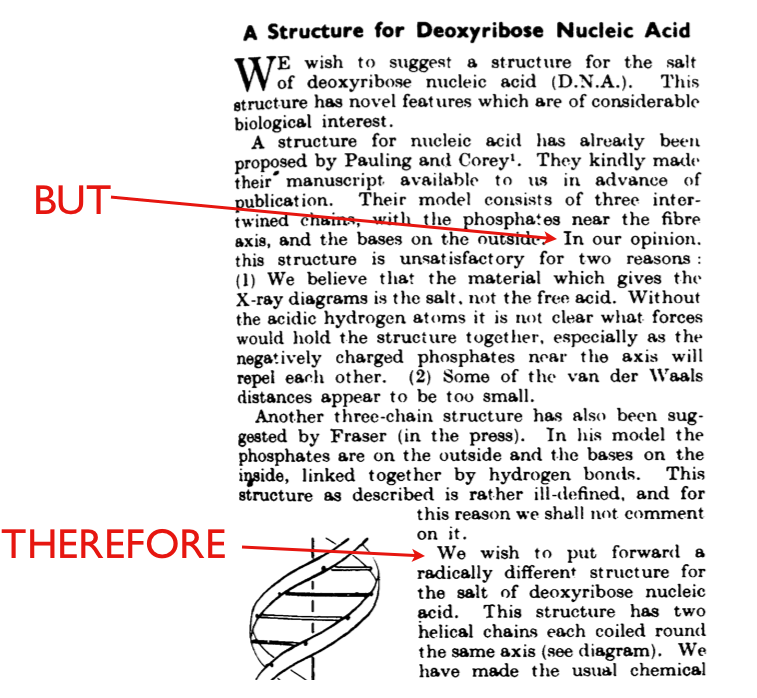#361) Yep, Watson and Crick were hip to the ABT, too
July 21st, 2014
Guess how Watson and Crick opened one of the most important papers in the entire history of science. Why aren’t we teaching the ABT at the very start of all science courses? You want to know how to do the most to improve the communication habits of scientists? The answer lies in these three letters. This will be part of my agenda next year with my new book from University of Chicago Press.
 IPSO FACTO, ABT. Try it for yourself. The structure is right there. Just add the words to the opening of Watson and Crick’s famous 1953 Nature paper describing the structure of DNA. And of course Watson went on to write one of the best pieces of science writing ever with, “The Double Helix.” These facts are not coincidence.
IPSO FACTO, ABT. Try it for yourself. The structure is right there. Just add the words to the opening of Watson and Crick’s famous 1953 Nature paper describing the structure of DNA. And of course Watson went on to write one of the best pieces of science writing ever with, “The Double Helix.” These facts are not coincidence.
ABT & GREATNESS: THEY GO TOGETHER
Earlier this year my buddy Park Howell at the Arizona State University Business School pointed out that the Gettysburg Address is an ABT. Last week at the North American Congress for Conservation Biology (NACCB) meeting, I met the wonderful Anne Greene, author of “Writing Science in Plain English” — a book that every science student should put to use. In her book she points to the sheer elegance of Watson and Crick’s landmark 1953 short paper in Nature where they presented the structure of DNA. She views that paper through her lens of simple English (it’s a marvelous example of using short words where others might use long ones). I view it from my lens of the ABT.
Yes, indeed, there it is — as clear as day, the ABT structure to open their paper.
The paper really is a masterpiece of effect research science communication. They open with two sentences that serve as an abstract, telling you what the paper is about. Then they launch into three sentences that could be connected with AND’s. These are then followed by the BUT.
Of course, they don’t have the “but” in the actual paper, however, if you put it in, you see it fits perfectly. Their “but clause” (do I sense a new term?) has two points along with a third separate point they dismiss, then they get to their part of the story where you could seamlessly add a THEREFORE if you wanted.
THE ABT SCAFFOLDING
Just like the Gettysburg address, it shows the potential scaffolding nature of the ABT — the idea that if you create a good ABT structure you can then remove these connector words and it stands up just fine.
We had two great workshop sessions last week at NACCB built around people developing their ABT’s. I’m now in the thick of my new book on narrative with University of Chicago Press. The ABT will be a central component. Lots more to come with it.
And for all the communications people who think the ABT is “something to add to your communications tips and tool kit,” I’m sorry, but no — it’s not a tip — it is THE essence of effective communication because it is THE narrative template. It’s where it all begins. And over the long term, if you’re not communicating narratively you’re not communicating effectively. That’s not a tip—it’s a rule.